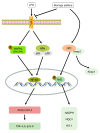Nutraceutical or Pharmacological Potential of Moringa oleifera Lam
- PMID: 29534518
- PMCID: PMC5872761
- DOI: 10.3390/nu10030343
Nutraceutical or Pharmacological Potential of Moringa oleifera Lam
Abstract
Moringa oleifera Lam. (M. oleifera), which belongs to the Moringaceae family, is a perennial deciduous tropical tree, and native to the south of the Himalayan Mountains in northern India. M. oleifera is rich in proteins, vitamin A, minerals, essential amino acids, antioxidants, and flavonoids, as well as isothiocyanates. The extracts from M. oleifera exhibit multiple nutraceutical or pharmacological functions including anti-inflammatory, antioxidant, anti-cancer, hepatoprotective, neuroprotective, hypoglycemic, and blood lipid-reducing functions. The beneficial functions of M. oleifera are strongly associated with its phytochemicals such as flavonoids or isothiocyanates with bioactivity. In this review, we summarize the research progress related to the bioactivity and pharmacological mechanisms of M. oleifera in the prevention and treatment of a series of chronic diseases-including inflammatory diseases, neuro-dysfunctional diseases, diabetes, and cancers-which will provide a reference for its potential application in the prevention and treatment of chronic diseases or health promotion.
Keywords: Moringa oleifera; cancer; chronic disease; flavonoids; metabolism; pharmacological potential.
Conflict of interest statement
These authors have declared no conflict of interest.
Figures

References
-
- Mahmood K.T., Mugal T., Haq I.U. Moringa oleifera: A natural gift—A review. J. Pharm. Sci. Res. 2010;2:775–781.
-
- Banji O.J., Banji D., Kavitha R. Immunomodulatory effects of alcbholic and hydroalcoholic extracts of Moringa olifera Lam. leaves. Indian J. Exp. Biol. 2012;50:270–276. - PubMed
Publication types
MeSH terms
Substances
Grants and funding
LinkOut - more resources
Full Text Sources
Other Literature Sources
Medical

